Beyond Function: A History of Quilt Making
I made my first t-shirt quilt as a way to compromise between my sentimentality and my tiny apartment. It was a project with a specific purpose and function. It didn’t really occur to me to think about its aesthetics or see it as an artistic object at the time. As I made more t-shirt quilts, I continued to learn about quilt making through videos and blogs but was more focused on absorbing technical knowledge than I was at understanding the language and construction of traditional blocks. As I pieced together knowledge for my own purposes, I couldn’t help wonder about the various styles and traditions of quilt making. It was a history I wanted to know more about.
Quilting out of scarcity
Recognizing that “history of quilt making” is a huge topic, I narrowed my search to quilts made of reclaimed clothes, curious to see if scarcity or frugality was a motivating factor and if old clothes were a means to this end. I discovered a 2013 article from African Arts written by Henry John Drewal that specifically discusses clothing as a material for quilt making. The article begins with a history of the Siddi people, their enslavement (often as housekeepers) on the west coast of India, and their eventual migration southeast to the Karnataka region. Siddi women have a long tradition of making quilts from saris and old clothes, using a thick needle and thread to pass through both the bottom sari layer and top clothing layers at once. The end result is a style that is distinct to the artist but a stitch pattern that is recognizable in Siddi made quilts. While this construction technique was unique, the social exchanges and community described in the article was familiar. Overall, it was cool to see a tradition of using old clothes and a new quilting technique. Beyond this, it was nice to be connected to the place and people who invented this tradition.
After this bit of research, I was more interested in exploring the history of early quilt making around the world. My research led me to older examples of quilts in books and the permanent collections of museums. A recurring theme of this research does confirm part of my first question — that people were certainly mindful of waste when making quilts, incorporating scraps and reclaimed materials when resources were scarce (source: PEI, 2017). Beyond this though, the biggest takeaway of my brief reading so far is that quilt making is a significant art form that extends beyond function.
Photos of these quilts: To view images of these quilts, visit Henry John Drewal’s website.
“Work clothes” quilts from Gee’s Bend: See a variety of quilts made from worn out clothes - soulsgrowndeep.org
Quilting as a way of documenting
Subsequent research into larger questions like “history of quilt making” introduced me to Harriet Powers who made story quilts. Her Pictorial quilt on display at the Museum of Fine Arts in Boston and includes oral descriptions of the 15 blocks pictured (Link). Her Bible Quilt 1886 (pictured below) is on display at the National Museum of American History. Both of these quilts are incredibly detailed and use applique to depict events from the bible and her own life. Powers was born into slavery in Georgia in 1837. It’s such a shame that there aren’t more firsthand accounts from Harriet Powers about her work but nonetheless her legacy and story quilts remain an inspiration. You can read a narrative account of how the Bible Quilt came into possession of The National Museum of American History on their website.
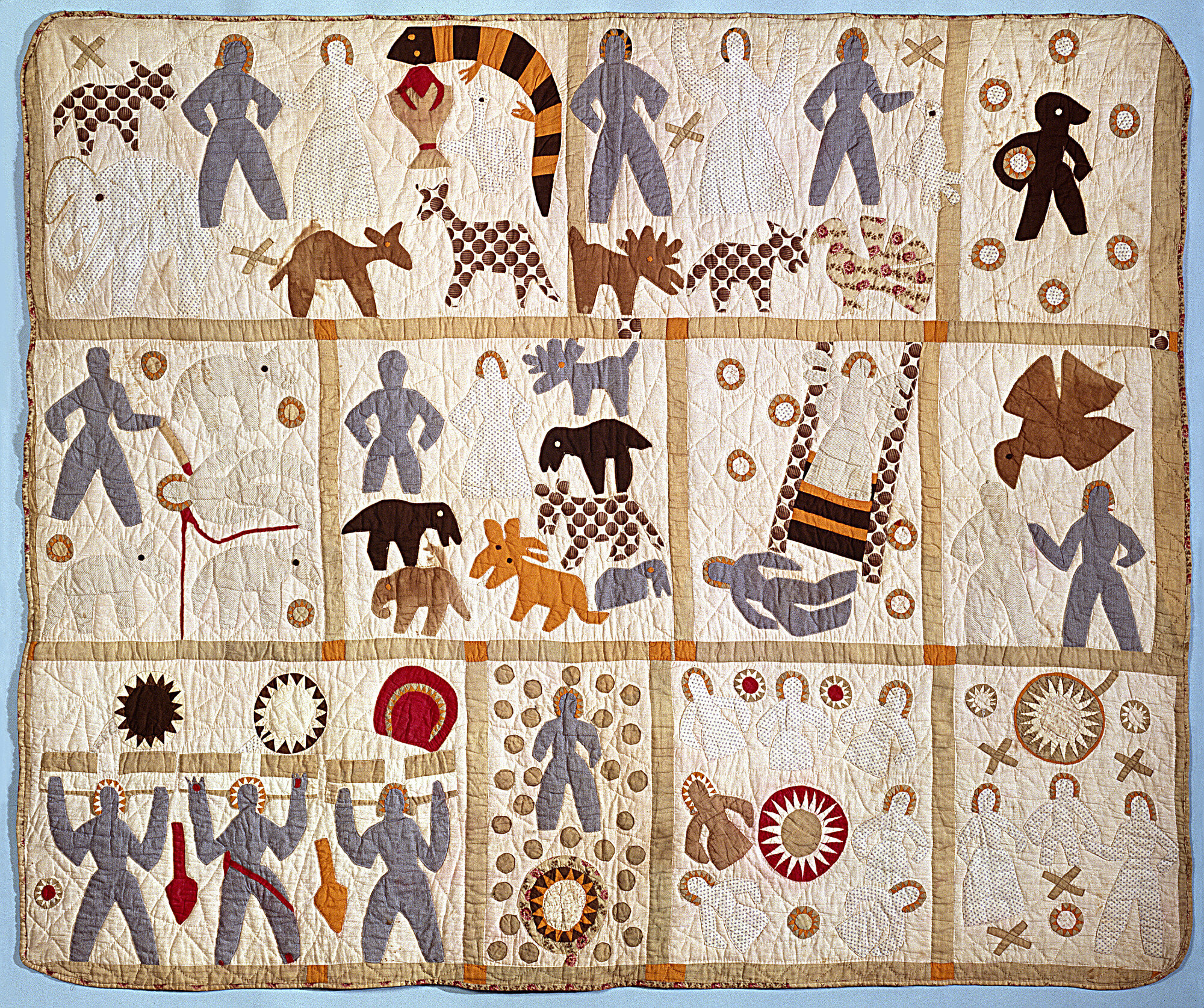
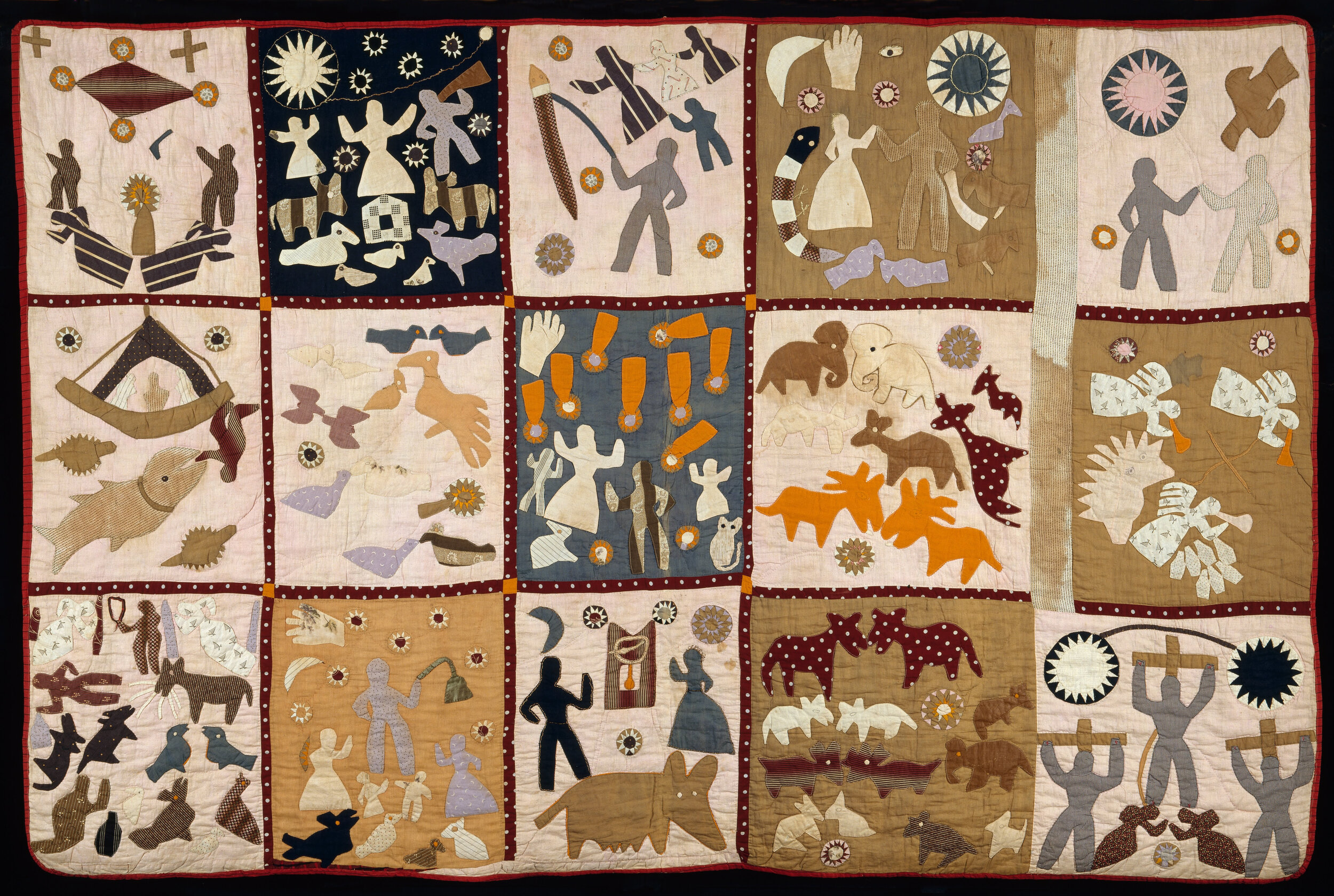
Further reading: There are several mentions of applique as an African art form and attributions to this technique in ancient Egypt. I wanted to see though, what other accounts exist across the continent. I only completed quick research and found two sources that place applique is West African history in present day Benin. I found a blog post on the Dahomey people (Kimani, 2018) and an African Arts article on appliqued cloths in Fon culture (Adams, 1980).
Quilting as storytelling
A contemporary example of an artist who uses applique is Bisa Butler, an American artist who makes vibrant portrait quilts of Black families and individuals. A 2019 article by Halima Taha in Sugarcane Magazine dives deeper into Butler’s inspirations and influences, including Elizabeth Catlett and AfriCOBRA (African Commune of Bad Relevant Artists), a Chicago based collective whose work incorporates positive images and representations of Blackness. Bisa Butler’s quilts are incredibly colourful and I can only imagine what it would be like to stand in front of such a large piece and be able to see all of the textures and patterns in her fabrics. On multiple occasions she has described working from enlarged archival photographs, sketching over them and chooses fabric to block out the light and shadows. I am in awe of her technical skills and knowledge but of her vision and ability to plan out such breathtaking pieces. The most touching and inspiring part about Bisa Butler’s process is how thoughtful she is — from the subjects she has chosen to the textiles she is laying down and stitching — everything is intentional. It’s this attention to detail that brings her portraits to life and gives her subjects a richness and a joy that is so often missing from depictions of Black life. As someone who has aspirations to make more artistic quilts, it’s special to be inspired by someone with such a clear voice and vision, and who is so technically talented.
Read more about her creative process, photo and fabric selection:
Bisa Butler’s Stitching History (Juxtapoz Magazine, Fall 2020). Link.
Artist Bisa Butler Stitches Together the African American Experience (Smithsoniam Magazine, July 2020). Link.
To see images of Bisa Butler’s quilts, visit her website: https://www.bisabutler.com
Quilting and community
It was in grade 3 social studies during a lesson on pioneers that I first learned of the “quilting bee”. While I recognized the social component of sewing, I always understood it as an efficient way to make a quilt by hand before the invention of the electric sewing machine. Once again, a bit of research disproves my misconception: quilts are functional but function is not a motivating factor in their creation. Quilt making is more than a social gathering, it is a community of care and practice. Take for instance the women of Gee’s Bend, a rural community in Alabama with a long history of quilt making passed on through generations. Over hundreds of years, women of Gee’s Bend have produced beautiful quilts that have been recognized and celebrated in books and exhibitions. In fact, the dress in Michelle Obama’s portrait was selected by the artist Amy Sherald because it reminded her of the stripe blocks used in Gee’s Bend quilts and was a nod to the long history of quilting in Black communities (St. Félix, 2018). This anecdote reminds me of the same thought and attention to detail that Bisa Butler considers when selecting her fabric. I love these insights. I love the layers of history that Mrs. Obama’s portrait shares. I love the power of art, and that its influence transcends across disciplines. Even if the audience is not aware of every conscious choice an artist makes, the legacies of artist tradition and practice live on.
Aside: A New York Times short documentary features women of Gee’s Bend. Towards the end, Mary Lee Bendolph mentions missing her quilts and not knowing what happened to them (Marris, 12:33-12:50). There are few news articles about lawsuit involving Gee’s Bend quilts; though the case was dismissed in 2008, details of how it was resolved are unclear (Johnson, 2008).
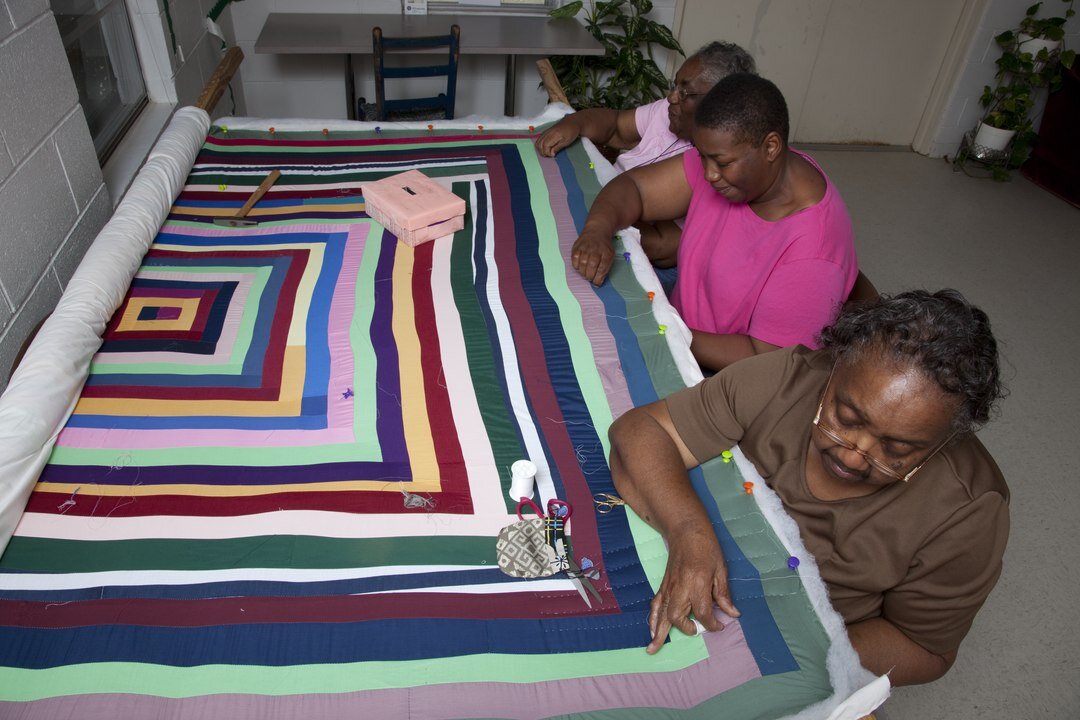
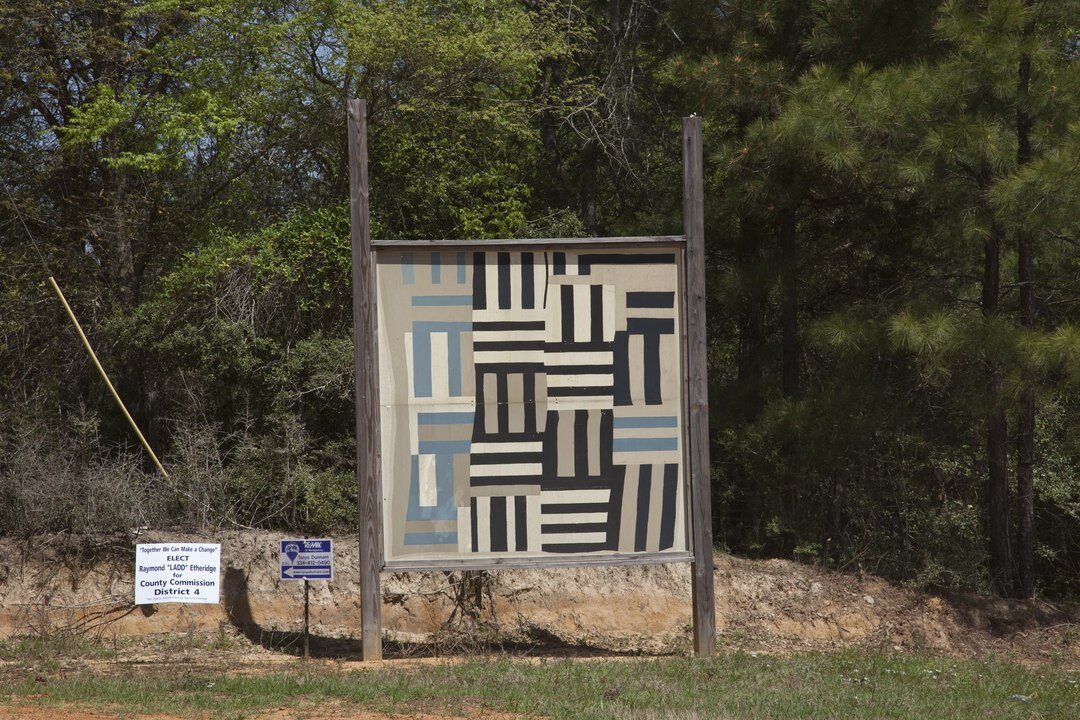
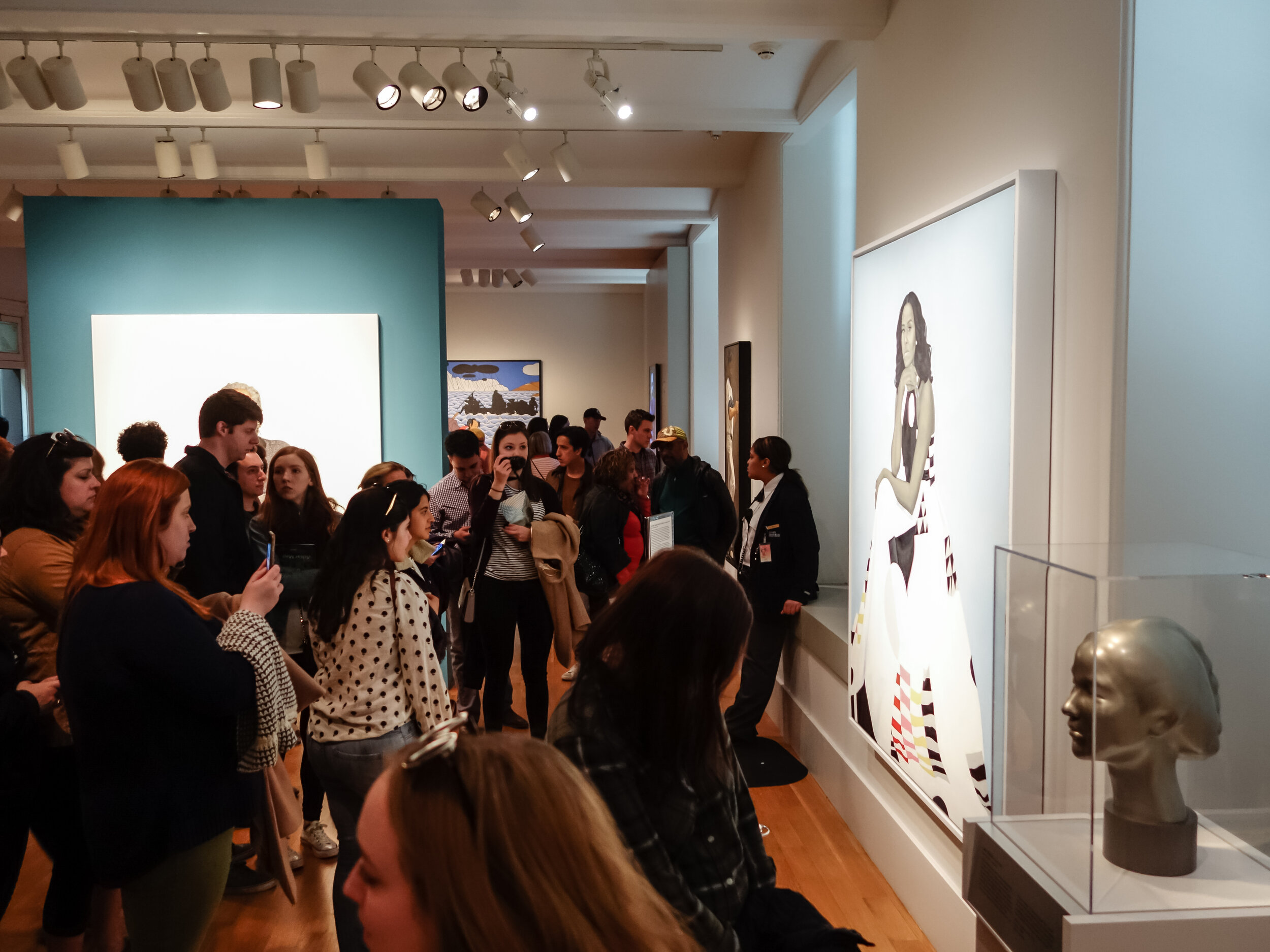
Quilting as memory
A quilt is a work of art that can last for hundreds of years. It’s the combination of the artist, their vision, and their materials that give the quilt added value and meaning. The NAMES Project AIDS Memorial Quilt is a massive, collaborative project that remembers and celebrates people who have lost their lives to AIDS. The project began in 1985 and was displayed publicly for the first time in 1987 at the National Mall. In the light of devastating events, the humanity of those affected cannot be lost. A national quilting project of such a scale is way to acknowledge individual pain and create a space for collective grieving. After its display at the National Mall, the AIDS Memorial Quilt sparked other countries to start similar commemorative projects, including Canada. Presently, the National Aids Memorial is overseeing this project’s legacy and panel contribution is still an ongoing activity.
Quilting in fashion
I’d be remiss not to mention that I came across several accounts of the first examples of quilted fabric being from clothing, as a way to provide additional insulation. A commonly seen example of this is the puffy coat or vest, which seems to have gotten even puffier in recent years (Gallagher, 2018). Even quilted knits for sweatshirts elevates a simple silhouette into something a little dressier. As I attempt to make my own clothes, perhaps I’ll consider adding “quilted garment” somewhere on my list.
Things I Still Wonder About…
It’s quite amazing the amount of information that can be accessed with an internet connection, a public library card, and a computer. I am very interested in learning more about regional histories of quilting and the insight that can be gained from looking at quilt makers and their materials more closely. Although I’ve only scratched the surface on the documentation surrounding quilts, I was finding some gaps in information. After I finished reading about Siddi women making quilts from old clothes, I’ll admit that I jumped to Wikipedia’s “History of Quilting” entry, which as of this blog post, did not mention Africa or any African country in its summary. Now I know that Wikipedia is not a primary resource, or any source, to be cited but I was a bit surprised considering I had seen a fair bit of research on African-American quilt making in my early searches. However, even within these publications, I was skeptical of some of the information being presented. For example, Drewal describes slavery in ancient Islam, draws a comparison to European Colonial expansion and chattel slavery, and in so doing characterizes Siddi enslavement in a less harsh light, even going so far as to call more esteemed positions a “kind of career opening”. Although Drewal is a more accomplished researcher than I, the suggestion that opportunity justifies the exchange of one’s freedom lacks empathy. In a 2009 television interview with Georgia Public Broadcasting, Carol McCullough, who is ostensibly an admirer of Harriet Powers’ work, calls her “a person with not a lot of advantages in life”, which is a bit of an understatement for a woman born into slavery in America. Look, it’s clear that both of these people greatly admired the artists they studied and their work; it can be felt in the text and video. To not acknowledge the worlds in which these women lived is to not fully appreciate their art or the community for whom they made it.
Until I saw it on a video, I didn’t have the words for it. But after I tried improv quilting, I fell in love with the freedom of the technique and was inspired to apply it to other quilting projects. Until I did this research, I had no idea “crazy quilts” of the 19th century or collaborative quilting projects. When I made my first quilt, I had no idea about applique or its roots in West African traditions and culture. I’m compelled to dig deeper into the available information to understand the history of quilting and the makers who were inspired by so much more than function.
Works Cited
Adams, Moni. “Fon Appliqued Cloths” African Arts. Vol. 13, No. 2 (Feb, 1980), pp. 28-41+87-88.
“Bible Quilt”. National Museum of American History. Last accessed February 9, 2021. https://americanhistory.si.edu/collections/search/object/nmah_556462
Curran, Marris. “How a Group of Women in This Small Alabama Town Perfected the Art of Quilting | Op-Docs” Youtube uploaded by New York Times. Nov 18, 2018. Last accessed February 9, 2021: https://youtu.be/YHEqYVzSs7U
Drewal, John Henry. Soulful Stitching: Patchwork Quilts by Africans (Siddis) of India. African Arts, Vol. 46, No. 1 (Spring 2013), pp. 6-17 Last accessed Feb 2, 2021: https://www.jstor.org/stable/43306121
Gallagher, Jacob. “Your Puffy Coat is Too Puffy”. Wall Street Journal. November 14, 2018. Last accessed February 8, 2021: https://www.wsj.com/articles/your-puffy-coat-is-too-puffy-1542210495
Gee’s Bend Quiltmakers. Souls Grow Deep Last accessed February 8, 2021: https://www.soulsgrowndeep.org/gees-bend-quiltmakers
Johnson, Bob. “Gee’s Bend quilts lawsuits resolved”. Seattle Times. August 26, 2008. Last accessed February 9, 2021: https://www.seattletimes.com/entertainment/gees-bend-quilts-lawsuits-resolved/
Kimani, Natalie. “ABOMEY APPLIQUÉ: Remnants Of A Fallen Kingdom, Made In Benin”. The Designer Studio. November 18, 2018. Last accessed February 8, 2021: https://tdsblog.com/abomey-applique/
The PEI Advisory Council on the Status of Women and the PEI Interministerial Women’s Secretariat. First hand: arts, crafts, and culture created by PEI Women of the 20th Century. 2002. PDF published online in 2017 on www.gov.pe.ca/firsthand but no longer available. I accessed a PDF copy online from Toronto Public Libraries.
“Pictorial quilt”. Museum of Fine Art Boston. Last accessed February 8, 2020. https://collections.mfa.org/objects/116166
“Sewing History: Harriet Powers.” GPB Education. Originally aired 01/15/2009. Las accessed February 8, 2021. https://www.youtube.com/watch?v=uP3RP1W1rPA&t=52s.
St. Félix, Doreen. “The Mystery of Amy Sherald’s Portrait of Michelle Obama”. The New Yorker. Feb 13, 2018. Last accessed February 8, 2021. https://www.newyorker.com/culture/annals-of-appearances/the-mystery-of-amy-sheralds-portrait-of-michelle-obama
Taha, Halimah. “AfriCOBRA’s Daughter: Bisa Butler” Sugar Cane Magazine. November 29, 2019. Last accessed February 8, 2020. https://sugarcanemag.com/2019/11/africobras-daughter-bisa-butler-by-halimah-taha/
“The history of the quilt”. The National Quilt Memorial. https://www.aidsmemorial.org.
